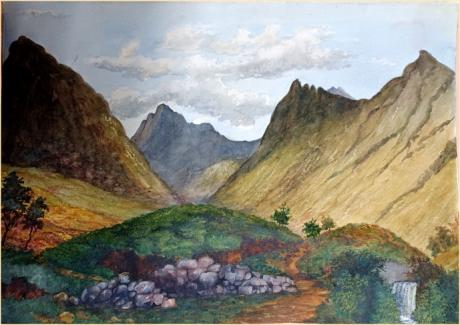signed inscribed and dated
Sannox (Scottish Gaelic: Sannaig) is a village on the Isle of Arran, Scotland. The village is within the parish of Kilbride.[1] The name comes from the name the Vikings gave to the area, Sandvik, meaning the Sandy Bay.
Within North Glen Sannox it is possible to find an Iron Age fort and the remains of a village, abandoned in 1829 as part of the process of the Highland clearances. Most of the inhabitants of this village emigrated to Canada where they built a replica of the church that was constructed in Sannox in 1822. The replica church in Inverness, Quebec, is no longer there (since the 1950s) and only the cemetery remains. Remains of the houses and runrigs - a type of farming common in western Scotland at the time - are visible throughout North Glen Sannox.
Mining was a source of employment in the area, when in 1840 a mine was opened in Glen Sannox. However operations only lasted around two decades. Operations ended when in 1862 the 11th Duke of Hamilton closed the mine, claiming that it spoiled the local area. However, the mine was reopened after the close of the First World War, and a railway and pier were built to transport the barytes that was mined there.
The source of barytes ran out in 1938 and the mine closed. The railway and pier to which it ran were removed in the 1940s, though the remains of the latter can still be seen on Sannox beach.The cemetery in Glen Sannox used to house a small chapel. It is the burial site of Edwin Muir, who was murdered on Goatfell in 1889 by John Laurie.Sannox sits on the east coast of the Isle of Arran, with a stunning backdrop of scenery in the shape of Glen Sannox. To the north lies North Glen Sannox. The A841 road passes through to Lochranza, on a stretch of road known locally as the Boguille. Sannox is the location of the Corrie Golf Club,[2] a nine-hole golf course, named after the locally twinned village of Corrie. It is also the location of Sannox Cricket Club.
In the north-east of the site, in North Glen Sannox, there are exposures formed duringthe Ordovician period, which occurred about 470 million years ago. These formedwhen the floor of an ancient ocean was squeezed between what is now the Highlands and Midland Valley, along what is now the Highland Boundary Fault. The Glen Sannox rocks represent one of a number of narrow, ‘fault-bounded’ exposures, consisting of
Ordovician ocean floor sediments (silts and muds) and igneous (volcanic) rocks that outcrop intermittently along the Highland Boundary Fault Zone. The oldest of the Glen Sannox Ordovician igneous rocks are pillow lavas formed from molten rock on the ancient ocean floor that once separated the Highlands from the lowlands. The Ordovician Igneous feature is deemed to be in favourable condition as the key exposures remain intact with regard to extent, composition and structure. However there has been significant hammering of the shale and pillow lavas in the Sannox Burn area that is likely to have a detrimental effect on the feature and therefore it may be appropriate to adopt a no hammering policy and erect signs explaining why hammering and fossil collecting should be minimised.
Barytes, a heavy barium mineral, was mined in Glen Sannox during the last century and between the World Wars. There are disused mine buildings at the river in Glen Sannox and excavations and spoil mounds extend northwards up the slopes of Cnocan Donna. Historically there has been occasional peat cutting at Sannox for domestic use. The northern mountains of Arran are a very popular mountain recreation destination. Footpath repairs and construction are continually required to reduce the erosion and damage to fragile upland pathways from recreational pressure. Loose stones have been removed from scree in Glen Rosa and Glen Sannox for footpath repairs in the past. Stones are transferred by helicopter to the relevant sites. The Arran Access Trust was set up in 1999 to address access issues and it is hoped that the Trust will continue to facilitate a wider programme of footpath repairs and maintenance.

